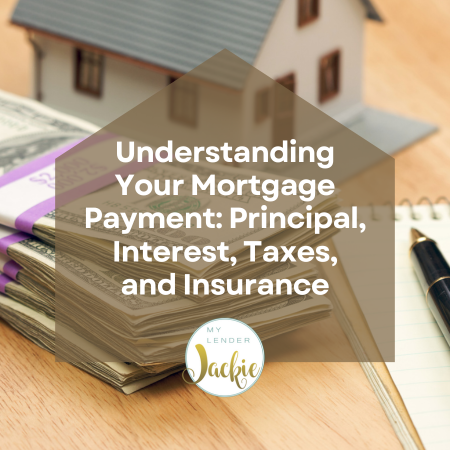Have you heard the acronym PITI and aren’t sure you understand what it means? When you’re looking at your projected mortgage expenses as you prepare to buy a home, the monthly mortgage payment you make will include the principal, interest, taxes, and insurance, also known as the PITI. Let’s dive into each of these parts and see how they contribute to your overall mortgage payment to help you move forward with applying for a mortgage with confidence.
Principal: Paying Down the Loan Balance

Paying down your principal builds equity in your home, which is your ownership stake in the property. The more you pay off, the more equity you gain. Principal payments don’t just reduce your balance—they also reduce the interest you’ll pay over the life of the loan. The lower your balance, the less interest you accrue each month, especially if you’re on an amortizing schedule (which is the common structure for fixed-rate loans).
Interest: The Cost of Borrowing
Paying back your loan isn’t as simple as just dividing up the amount your borrowed over the number of payments you will make. Interest is the fee you pay for borrowing money. Calculated as a percentage of your loan’s outstanding balance, it’s based on your mortgage interest rate and is paid over the life of the loan. Your interest rate can be fixed (meaning it stays the same) or adjustable (meaning it can change periodically).
In the early years of your loan, the majority of your monthly payment will go toward interest. As you continue to pay down the principal, however, your interest payments will gradually decrease. Interest rates have a huge impact on the total cost of your loan. A lower interest rate can save you thousands (or even tens of thousands) of dollars over the life of the mortgage, which is why it’s important to do what you can to get the lowest rate, including having a strong credit score.
Property Taxes: Supporting Local Services
Property taxes are a critical part of your mortgage payment. When you own a home, you’ll be required to pay annual property taxes based on the assessed value of your property and the tax rate set by your local government. These taxes fund essential services like public schools, emergency services, road maintenance, and local government operations.
When you pay your monthly mortgage payment, a portion of it can be set aside in an escrow account so that your taxes can be paid out of the account. While you don’t always have to pay your property taxes this way, most lenders require you to pay your property taxes monthly as part of your mortgage payment. This amount is set aside in an escrow account, and your lender will pay the taxes on your behalf when they’re due.
Homeowner’s Insurance: Protecting Your Investment
Finally, your monthly payment will include a monthly homeowners insurance premium. Homeowner’s insurance protects both you and us as your your lender in case of damage to your property. It typically covers events like fires, storms, theft, and certain natural disasters. It’s required by almost all lenders to protect their interest in your property, and your insurance premium will usually be part of your monthly mortgage payment.
Together, these components—Principal, Interest, Taxes, and Insurance—make up your total mortgage payment, often referred to as PITI. When we calculate your mortgage affordability, we are looking at your PITI payment, as it reflects the total monthly obligation associated with owning a home, not just the actual money you’re borrowing for the purchase price. Understanding each component helps you get a clear picture of your financial commitment and enables you to make informed decisions about your budget and homeownership.
If you want to learn more about choosing a mortgage that suits your needs or how to apply for a mortgage, we can help. Contact us any time to find out how we’ve helped so many clients over decades to get the financing they need to pursue their goals.

